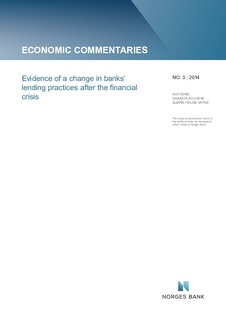| dc.contributor.author | Solheim, Haakon | |
| dc.contributor.author | Vatne, Bjørn Helge | |
| dc.date.accessioned | 2018-08-15T07:57:27Z | |
| dc.date.available | 2018-08-15T07:57:27Z | |
| dc.date.issued | 2014 | |
| dc.identifier.uri | http://hdl.handle.net/11250/2558052 | |
| dc.description.abstract | We analyse the behaviour of Norwegian households using tax return data that covers debt, income, financial assets and housing wealth. In the period from 2004 to 2008 borrowing in Norwegian households increased significantly. Behaviour changes after 2008. The Financial Supervisory Authority of Norway has recommended that banks impose stricter LTV (loan-to-value) requirements. We find that debt-to-housing value (DTV) has fallen from 2008 to 2012, especially among younger households. High income groups have been able to maintain a high level of debt to income, but have increased their holdings of liquid financial assets. Lower income groups take on less debt relative to income and have not been able to increase holdings of financial assets. | nb_NO |
| dc.language.iso | eng | nb_NO |
| dc.publisher | Norges Bank | nb_NO |
| dc.relation.ispartofseries | Economic Commentaries;3/2014 | |
| dc.rights | Attribution-NonCommercial-NoDerivatives 4.0 Internasjonal | * |
| dc.rights.uri | http://creativecommons.org/licenses/by-nc-nd/4.0/deed.no | * |
| dc.title | Evidence of a Change in Banks’ Lending Practices After the Financial Crisis | nb_NO |
| dc.type | Others | nb_NO |
| dc.description.version | publishedVersion | nb_NO |
| dc.subject.nsi | VDP::Samfunnsvitenskap: 200::Økonomi: 210::Samfunnsøkonomi: 212 | nb_NO |
| dc.source.pagenumber | 9 | nb_NO |

